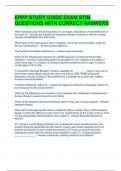Other
applied science Unit 4 assignment B synthesising an ester
- Module
- Unit 4
- Institution
- PEARSON (PEARSON)
This is BTEC level 3 Applied science unit 4 assignment B laboratory techniques and their application . The assignment is written to distinction standards and I was given a DISTINCTION for this assignment in unit 4. .This assignment goes through each criteria in much detail. I hope you find my assi...
[Show more]












